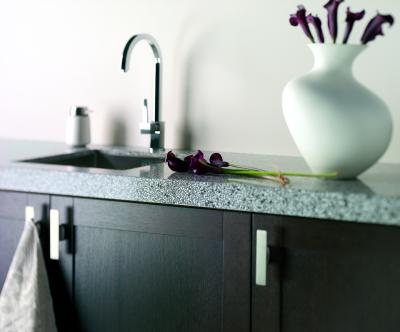Popular Kitchen Benchtop Materials
If you are renovating your kitchen, it is incomplete without a perfect kitchen benchtop. It is a very important feature. Moreover, it adds value to your property. Selecting the kitchen benchtop is the most exciting thing in the designing process. As benchtops are the most affected from the wear and tear in the kitchen, choosing the correct one is the most difficult decision, especially when it comes to materials. There are numerous options available for selecting a kitchen benchtop material. Below listed are a few popular kitchen benchtop materials used to make your kitchen benches look great.

Stone benchtops – Natural and Engineered
Many people love the use of natural stone for their kitchen benchtops. The beautifully edged granites, the fabulous travertine, the lavish look of marbles and its different variations all gives a stylish look. Stone benchtops require high maintenance and are expensive. By nature, it is soft and porous. Therefore, anything that is acidic or citrus can leave a scratch on the stone. Moreover, tea, coffee, wine, and water also can leave stains. If using a natural stone benchtop one should ensure that a protective sealer is used that does not allow the spills to absorb into the stone.
The engineered stone benchtop is a new kid on the block. It is being used widely. It is made from the ground quartz or granite and then mixed with resin. It is then engineered to give a similar look as that of a natural stone. It is comparatively cheaper and less porous. It is available in a wide palette of neutral patterns and tones along with semi-precious stone and decorative glasses. Because of the composition and sealing of the engineered material, it is more durable in the kitchen.
Metal
Earlier metal benchtops were used only in commercial kitchens. But now-a–days it is trending in homes too with copper, stainless steel, and aluminium as the obvious choices. It requires low maintenance. It has a masculine vibe and is a tough material.
A stainless steel benchtop although durable and stain proof will easily show up fingerprints and streaks. It can also be easily scratched. To avoid scratches brushed steel can be used instead.
Concrete
Similar to marble, concrete is scratch and heat resistant. It is durable and edgy. It is the leading choice for renovators who are crazy about aesthetics. You can be very creative with cement. By adding elements such as coloured oxide to concrete and corrugated iron, it can create an amazing colourful texture and shape with a unique finishing.
Concrete has low tensile strength and so it is restricted in terms of span, thickness, and overhangs. It can also easily crack or chip. It is less expensive but its installation can be costly because of its weight it may require more skilled labour.
Timber
A timber kitchen benchtop is an economical alternative which is never out of fashion, whether you prefer a modern and sleek appearance or rustic and raw. It is a natural product. You can select the colour appearance and finish and with a skilled craftsman, it can create wonders. You can construct your bench with a single plank or it can be stitched together depending on how creative is the craftsman team.
One should opt for a durable hardwood version rather than a softer one for avoiding damages. Reclaimed timber is environment-friendly and more durable. Timber is regarded as a softer surface than the stone benchtops. It is ideal for the fragile crockery, food preparing surface, and also lower in cost compared to the stone and other benchtops.
 Laminate
This benchtop material has a huge variety of colours and textures. It is available in stone type designs, timber look, and various solid colours. It comes in both gloss and matte finish. Its edges are a bit round or square. The latest innovation in laminates is that it is now available in 20mm thickness which gives a sleek modern appearance. Although its price varies depending on its width and the type of finish selected, they are budget friendly. They are very easy to clean. They are prone to scratches and chip and crack so it is advisable to use a cutting board while preparing food.
Laminate
This benchtop material has a huge variety of colours and textures. It is available in stone type designs, timber look, and various solid colours. It comes in both gloss and matte finish. Its edges are a bit round or square. The latest innovation in laminates is that it is now available in 20mm thickness which gives a sleek modern appearance. Although its price varies depending on its width and the type of finish selected, they are budget friendly. They are very easy to clean. They are prone to scratches and chip and crack so it is advisable to use a cutting board while preparing food.
Therefore, with a wide range of kitchen benchtop materials available you can make your benchtop according to your needs and requirement.